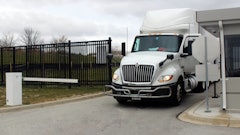Feeding The Hungry
Who: The Food Bank for New York City, Hunt's Point, NY, an organization that provides more than 67 million pounds of food annually to more than 1,200 nonprofit community food programs.
Why: Installs a WMS to dish out more food to the city's needy.
The largest food bank in the country and leading distributor of free fresh produce, the Food Bank For New York City serves 240,000 meals a day for New Yorkers who would otherwise go hungry. Every weekday food is collected, stored, repacked and distributed from its 100,000-square-foot warehouse located in the Hunts Point Cooperative Market in the Bronx. Fourteen to 16 tractors are dispatched daily to locations in the Bronx, Brooklyn, Queens and Staten Island.
To better handle this task, the Food Bank needed to replace its largely paper-based tracking system, where physical inventories were done manually and adjustments keyed into the system. "It was not an instant system," says Antonio Peralta, director of IT. That, plus lost paperwork and inaccuracies, led Food Bank management to search for something that would help them better manage its inventory and better serve its customers.
The company discovered that the Krasdale Foods DC just down the street had installed a system to tackle similar challenges. The application implemented at Krasdale featured hand-held terminals, barcode scanning and the Open Warehouse Management System (OpenWMS) from Control Solutions Inc. (CSI), of North Branch, NJ. The OpenWMS is a real-time system, with receiving, directed putaway and picking features.
Integrator CSI came out to the Food Bank facility to spec out the system and do a site survey to establish where access points would be needed for radio communications between the host system, hand-held terminals and forklift-mounted terminals workers used as they roamed the sprawling warehouse. Plans also needed to include a connection to Microsoft's Navision Financial System that Food Bank management planned to implement.
The WMS was installed in 2002, and the financial end was connected in 2004.
Having a constantly updated inventory that truly reflects what is on its shelves has had an impact on all parts of the Food Bank, says Peralta. In the warehouse, "there's no more paper and writing down quantities, which was very time-consuming. It's easier to select orders——workers know where they need to go," he says.
Because the WMS and order-taking systems are so well-integrated, the logistics department, where orders are processed, runs much more efficiently.
The system also has made a huge difference in Agency Services, which provides customer service for all its programs. The real-time aspect allows workers to say with conviction what they can provide because they know for certain what is in stock.
The Food Bank's paybacks are inventory integrity, accuracy, better customer service, and, of course, productivity. Now, workers conduct physical inventories three to four times faster than before.
Though no changes are planned for the immediate future, Peralta says, "I think we can improve how we use it."
For now, however, this is a great improvement. "We are distributing more food to the needy," says Peralta. "That's what it's all about."
Working With Carriers In A Difficult Environment
Who: Dial Corp., Scottsdale, AZ, the $1.3 billion consumer package manufacturer and subsidiary of the Henkel Group based in Dusseldorf, Germany.
Why: Yields 12 to 15 percent savings in high-volume lanes.
With trucking capacity what it is today, the pendulum has definitely swung in favor of the carriers. Dial Corp. has turned the tide back in its own favor, securing carriers when other companies found it difficult. Because of its strategy for managing carriers, Dial also has been able to secure transportation for its more than 130,000 finished goods shipments a year from 41 locations around the country at lower cost, while at the same time getting contracted carriers to improve their service, rates and overall performance.
Its transportation management strategy has greatly improved visibility to the carriers' activities in transit. "We've also improved carrier compliance with contracted rates, accessorials like fuel taxes and surcharges, and unplanned accessorials like detention charges," says Rob Shafer, Dial's manager of carrier alliances.
Dial has also gained 95 percent compliance for carrir reporting, mainly because freight payment is tied directly to it. "Our system will not authorize a payment until we have receipt of an invoice, so it's in the carriers' interests to expedite the processing of invoices," explains Shafer.
Its strategy for managing its contracted carriers—75 percent of which are asset-based carriers and the remaining 25 percent made up of third-party carriers—has yielded 12 percent to 15 percent savings in high-volume lanes. Carriers in those lanes did not miss a beat at all last year.
Event management is the key to this success. Using the Collaborative Logistics Network from Nistevo Corp., Eden Prairie, MN, Dial has automated and centralized its logistics operations and is now able to track carrier performance with alerts for expired or rejected tenders and for exceptions to shipment schedules.
Dial uses the online, subscription-based Nistevo solution for carrier selection, contract management, less-than-truckload consolidation, routing, dock scheduling, invoicing, freight tendering, freight settlement, freight payment, load building, managing direct-store delivery and factory gate pricing initiatives and more. The company plans to expand its use of Nistevo programs to cover returned goods and backhaul management.
Prior to implementing the Nistevo TMS package in August 2002, only about 40 percent of Dial's contracted carriers were using electronic data interchange (EDI) to communicate with the company. "Now, everything comes into us through EDI," says Shafer.
"Before, we had no way of knowing what carriers had what loads, or what were the in and out volumes of certain facilities," he adds.
Now we have real-time data about all that. We also have the ability to migrate information from disparate operations into one touch point."
"We've done a great deal with their applications and in today's transportation world, I'm not sure how we could have survived without it," says Shafer.
Sequencing Routes Was Never This Easy
Who: Piller's Sausages and Delicatessens Ltd., Waterloo, Ontario, a family-owned foodservice distributor, delivering European deli, smoked meats and sausages to retailers throughout North America.
Why: Switches to a Web-based service to improve fleet operations.
While strong sales growth is always good for the bottom line, it can also wreak havoc on the transportation department, as dispatchers for Piller's Sausages and Delicatessens Ltd. can attest to. As demand for Piller's products increased, dispatchers had to add new stops to its fixed delivery schedule and ensure that loads were balanced.
These tasks were done manually and became increasingly difficult to accomplish as the business grew. Piller's also had no visibility into its supply chain. While delays and exceptions could range from lack of dock space to heavy traffic, the key for Piller's was real-time access to this information.
Dispatchers needed to know the status of deliveries and where drivers where being held up—time wasted on one call could affect the rest of the day's delivery schedule and ultimately impact Piller's number one priority: customer service.
Piller's realized that it needed an efficient way to optimally sequence its routes following the order cut-off and prior to loading the vehicles. Dispatchers and managers had to be able to measure actual performance against an engineered plan, and required real-time visibility into its delivery operations to ensure ongoing customer satisfaction.
Toronto-based Cube Route introduced Piller's to its managed logistics service, which facilitates the deployment and management of the delivery process for transportation and field service organizations. Specifically, the Routing and Optimization Service provided by Cube Route offers a way to optimize routes, and track and monitor delivery fleets in real-time.
This logistics service combines routing, tracking and planning functionality with the simplicity of Web-based service delivery. It optimizes both static and dynamic routes for maximum efficiency by taking into account geographic zones, time windows and other constraints when organizing delivery fleets. It also provides dispatchers, managers and support agents with a real-time, global view of driver movement and delivery status across an entire fleet.
By using Cube Route sequencing functionality to create engineered routes, Piller's has significantly reduced its time and miles spent on the road. The actual performance and cost of each route are compared daily against an engineered plan. Using Web-enabled cell phones, the Piller's fleet and status of each delivery is now tracked in real-time. Drivers capture data such as mileage, service time at each stop, exception handling and dock waiting times.
Getting WISE In The Warehouse
Who: The Jel Sert Co., West Chicago, IL, manufacturers of Pop-Ice, Otter Pops and Fla-Vor-Ice freezer pops; Mondo Fruit Squeezers; and Royal and My*T*Fine brands.
Why: Increases employee productivity 30 percent.
When your business is based on the timely delivery of high-quality products, the efficient management of the distribution center becomes critical. As the Jel Sert Co. was expanding its business to support new brands and new channels, it was clear its current physical and IT infrastructure could not support its increasingly complex business demands.
"Our business was expanding and our distribution requirements became too complex for a manual environment," says Andrew Rush, vice president of logistics and procurement. As a first step to expand its distribution capabilities, the company built a distribution center near its Chicago plant. The next step was to implement state-of-the-art technology to run that distribution center.
Several years earlier, Jel Sert selected financial, manufacturing, and sales management applications from Progress partner QAD to help run the business. However, the warehousing and distribution functions were based on labor-intensive manual processes. With the acquisition of the Royal and My*T*Fine brands, the increasing complexity of their distribution process, and the construction of its new DC, Jel Sert needed to automate those warehouse and distribution processes and integrate its business systems if the company wanted to maximize its growth potential.
"Our QAD ERP system provides the reliability and power we need to automate production," says Rush. "But we knew we needed to automate warehousing and distribution." The addition of new products and channels was increasing the complexity of the business. For example, Jel Sert's acquisition of the Royal brand doubled the number of SKUs to track and manage. This acquisition also increased warehousing complexity and increased case picking requirements.
Previously, most of the Jel Sert products were shipped on full pallets, but the many different flavors of the Royal products required a greater shift toward partial pallet warehousing, picking and shipping—which required increased labor for storage and case picking.
Jel Sert wanted continue to build on the reliability, low cost of ownership and ease of maintenance of its Progress database environment and development tools. To support its need for an automated system, Jel Sert selected the rules-based Warehouse Information System Expert (WISE) applications from Royal 4, a Progress partner based in Long Beach, CA. WISE provides the software infrastructure to manage inventories, pick-and-pack orders, perform value-added operations and ship customer orders according to detailed customer instructions.
Built on the flexible OpenEdge platform, WISE easily integrates with Jel Sert's existing business systems, enabling management to gain an enterprise view of production and warehousing.
Inventory is tracked from the moment it is received through every step of the warehousing process until it is shipped. All finished goods inventory is controlled at the item level, by SKU number, and by quantity, location and lot. Stocking and picking tasks are automatically generated according to flexible business rules defined in the WISE application. Jel Sert built a radio frequency (RF) wireless network to communicate with employees throughout the distribution center, and WISE allows management to run the distribution center using real-time inventory status and quantities.
Extensive stocking functionality allows Jel Sert to utilize many different styles and methods of putaway stocking techniques. Using the wireless network to communicate the putaway tasks, WISE directs distribution center employees to the proper location—with the correct equipment—in the most efficient route and manner. All RF putaway transactions are confirmed with a location barcode scan to ensure real-time inventory accuracy.
Rush estimates that warehouse employee productivity has already increased more than 30 percent. Despite growth in orders, inventories and SKUs since implementing WISE, Jel Sert has improved labor productivity. "Our employees know exactly what to do and they have the tools they need to do their jobs well. Each forklift has a computer and employees have handheld devices that automatically provide detailed instructions," he says.
In addition, the company has increased full pallet accuracy from about 80 percent to 99.93 percent and partial case accuracy from about 60 percent to 99.94 percent.
Standing Ahead Of The Pack
Who: Ozburn-Hessey Logistics, Nashville, TN, nation's largest privately held third-party logistics provider.
Why: Emerges as a dominant 3PL player in the food industry.
Ozburn-Hessey Logistics has been at the forefront of national logistics companies since 1951, when Frank Ozburn and Kenneth Hessey established the company in Nashville. Over the past several years, OH Logistics has emerged as a dominant player in food logistics by delivering a double punch as a food consolidator and transportation provider.
Through its asset-based Lanter division, OH Logistics redistributes dry and temperature-controlled food products throughout the country using strategically located warehouses in major hubs like Indianapolis; Chicago; St. Louis; Atlanta; Dallas; Reno, NV; and Harrisburg, PA, among others.
Its accomplishments have netted it accolades in the foodservice industry from such giants as Sysco Corp. (2003 and 2004 3PL Warehouse of the Year Awards). At the heart of OH Logistics food service is its development of regional warehouses large enough to aggregate foodservice suppliers previously dispersed among smaller warehouses, thereby allowing food distributors greater efficiency and accelerated turns.
As a result they have been able to serve hundreds of foodservice suppliers from regional locations, which in turn have allowed those suppliers to better serve a common customer.
In addition, OH Logistics has begun implementing cross dock consolidation throughout the country which provides both suppliers and distributors more savings by allowing them to avoid storage costs while at the same time placing their products at strategically advantageous locations for their customers. OH Logistics continues to implement a campaign to place these food consolidation warehouses and crossdocks at strategic locations.
OH Logistics offers more than 19 million square feet of distribution space available in dedicated and shared environments throughout the nation. In addition to its food consolidation, OH Logistics has been one of the country's leading innovators on "shared" or flexspace, which ensures that its customers do not commit to space they do not need and that additional space is always available to them when required.
OH Logistics has also quickly become a leading radio-frequency identification technology solutions provider in the food marketplace seeking to adopt the new technology standard. In July 2004, OH Logistics became one of the first third-party logistics firms to implement an RFID compliance center, which it opened at its Dallas Regional Distribution Campus to service a major pharmaceutical company and Wal-Mart.
More importantly, OH Logistics incorporated RFID within its own warehouse-management system. In this, way, it can provide a fully integrated distribution network using the new technology standard to all its food distribution customers who are requiring it.
The Logistics Behind Vending Machines
Who: Four Square, a U.K.-based subsidiary of Mars Inc.,
operates beverage vending machines throughout Europe.
Why: Outsources the entire lifecycle of vending machines.
With more than 1 billion drinks sold globally, Four Square ranks amongst the top beverage retailers worldwide, selling brand names such as Jacobs, Nestlé, Lipton and Knorr from vending machines.
Four Square worked with a number of different companies to handle the logistics, including the transportation and the installation of the vending machines.
This meant that the transportation——carried out via a transportation company, and the set-up of the vending machines——handled by Four Square technicians, were two very separate processes. The result: doubling of costs and complicated coordination. When a vending machine required maintenance, the organizational efforts were even higher and additional costs were incurred.
In addition, the separation of transport and installation also caused Four Square's customers great inconvenience.
Four Square turned to UPS Supply Chain Solutions, a business unit of UPS, which had already been transporting and installing its vending machines. Today UPS manages the entire lifecycle of the vending machines.
"We were looking for a logistics company with a proven track record that was able to provide a cost-efficient solution. We also
needed a partner who could offer our customers the same level of service that we promised. The only company able to satisfy our individual needs was UPS," says Michael Fuchs, Four Square's director.
The service includes delivery, installation, instructions on use, technical advice, repairs, returns, refurbishment and recycling.
UPS stores the machines that arrive in Germany from the United Kingdom in its warehouses. Once an order is placed, UPS specialists customize the machines according to customer demands. The machines are loaded with the required products, they are programmed to discharge the appropriate amount of water for each drink or soup, and the correct keys are assigned to each beverage.
Finally, the machines are transported to their location, where they are installed by two UPS employees. Once the machines are connected, the cooling systems are checked and users are briefed on how to operate them. Old vending machines are collected at the same time. Once back at the UPS facility, the old machines are classified according to their maintenance needs. Some machines that can be reused are refurbished; others are taken apart and recycled.
In addition to handling the machines themselves, UPS also takes care of administrative tasks such as organizing deliveries with Four Square customers.
As a result, Four Square now has a single contact for all its logistics needs. Because UPS handles the entire lifecycle service for vending machines, the company is capable of giving Four Square increased visibility into its supply chain.
<><><><><><><><><><><><><><><><><><><><><><><><><><><><><><><><><>
Online Grocers: Big Business In The Big Apple
Who: Fresh Direct, Long Island City, NY, is an on-line grocer serving more than 75,000 consumers in Manhattan.
Why: Makes on-line grocery shopping interesting again.
---------------------------------------------------
After the demise of Webvan, the on-line grocer that lost more than $1 billion dollars before it went belly up in 2000, there were many who believed that home delivery was not going to work for food. But Fresh Direct is taking a different approach. The company, which operates out of a 300,000-square-foot facility just outside of Manhattan, has learned from its predecessor's mistakes——namely, ramp up slowly, invest in the right technology, offer prices between 10 percent and 35 percent below market, and make sure your customers are completely satisfied. So far, it appears to be paying off for Fresh Direct. It's currently adding about 2,000 new customers each week.
<><><><><><><><><><><><><><><><><><><><><><><><><><><><><><><><><>
This Forecast Calls For More Accuracy
Who: Ventura Foods LLC, Brea, CA, a wholesale
supplier of edible oils, margarine, shortenings, dressing and flavor bases.
Why: Improves forecast accuracy by 60 percent.
---------------------------------------------------------
Challenged with balancing volatile customer demand with daily fluctuations in edible oil prices, Ventura Foods needed to find a new approach to demand forecasting. The company turned to the Real—Time Forecasting (RTF) solution from Terra Technology, Norwalk, CT. Terra developed RTF to enable companies to leverage their existing forecasting applications to provide a more accurate picture of demand for the next month or so—which typically is the most critical and costly time for deployment and scheduling decisions.
Since implementing the system last year, Ventura has been able to lower inventory levels, manage transportation costs and reduce forecast error.
"When forecast error is high, we are forced to expedite shipments, and expedited shipping costs can be as much as two-and-one-half times higher than normal transportation costs," says Larry Felhauer, Ventura's vice president of supply chain. "Improving forecast accuracy provides significant cost savings for us."
Indeed, the software solution has allowed Ventura Foods to improve forecast accuracy from 49 percent to 79 percent as soon as it went live.
<><><><><><><><><><><><><><><><><><><><><><><><><><><><><><><><><>
Satellite Tracking For The Birds
Who: Perdue Farms, Salisbury, MD, one of the largest poultry companies in the world.
Why: To meet the demands of its
growing business, Purdue invests more than $40 million in innovative systems.
-------------------------------------------------------
For the folks at Perdue Farms, customer service is the number one priority."When you're dealing with fresh poultry, time is of the essence. We have customers waiting for our products to bump their dock so they can deliver to their customers," says Ray Hall, transportation manager."We need that level of assurance so we can tell them where their product is any time of the day or night."
To achieve a high level of customer service, Perdue has made a number of technology investments in recent years, including the OmniTRACS mobile communication system from Qualcomm Inc., San Diego.
OmniTRACS incorporates one of two available satellite-positioning technologies—the standard Qualcomm Automatic Satellite Position Reporting system and the optional Global Positioning System—to provide comprehensive tracking.
When Perdue was evaluating communications systems, it looked at a number of options, including cell phones and pagers, but neither solution met all of its needs."We realized we needed a system that interfaced with our dispatch software and made everything work together," says Hall.
The OmniTRACS system gives Perdue instant access to its drivers, reduces office staffing needs and increases driver efficiency. Plus, it can guarantee on-time deliveries—keeping its customers very happy.
















